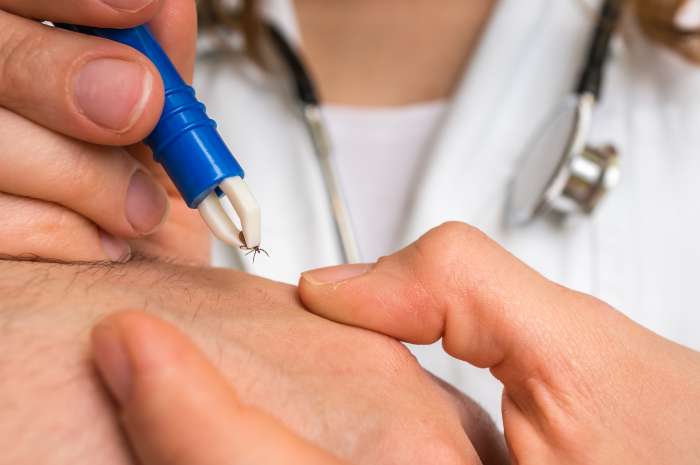Summer is already in full swing, which means camp, ice cream, swimming pools, and ticks. Wait--what? Ticks?! Well, whether we like it or not, ticks--small arachnids, but I prefer to just call them bugs, thankyouverymuch, that feed on the blood of mammals--are out there, and yes indeed, they often do land on the skin of children. Here's professional advice on how to check and remove ticks from a child's delicate skin.
How to Check and Remove Ticks
"The easiest way to prevent tick-borne illness is daily tick checks after exposure to a possibly tick-endemic area," Dr. Arielle Ornstein, a Rye Brook, NY-based pediatrician. "The ideal method for tick detection is in the bath, focusing on those areas easily accessible to ticks, such as armpits, groin, scalp and behind ears." This not only enhances visualization of ticks but can also wash off any unattached ticks, including reducing exposure to ticks remaining on clothing.
According to Dr. Teresa Amato, Chair of Emergency Medicine at LIJ Forest Hills in New York, "Showering shortly after being outdoors (within two hours) has been shown to reduce risk of getting Lyme disease."
What do you do if you find a tick?
If you find a tick, prompt removal is strongly recommended. According to Dr. Ornstein, multiple scientific studies have shown that a tick must be attached for over 36 hours in order to transmit any illness. "Ticks should be removed using a tweezer or forceps by grasping tick as close to the skin surface as possible and pull up firmly," she says. Try not to squeeze, jerk or twist. Clean skin with warm water and soap."
Once the tick is removed, Dr. Amato says to dispose of it by submersing it in alcohol, placing it in a sealed bag/container, wrapping it tightly in tape, or flushing it down the toilet. "Never crush a tick with your fingers, as this may transmit disease."
Monitor for a rash at the site of the tick bite, which can occur up to 30 days following. According to Dr. Ornstein, any testing for Lyme Disease cannot be done for a minimum of 3-4 weeks, and even then false positives are very common. Stay in touch with your doctor if you are concerned about your child's skin and symptons post-tick removal.
Beware of deer ticks
According to pest control company Orkin, deer ticks (Ixodes scapularis) feed on other large mammals as hosts, including humans. Humans, considered accidental hosts of deer ticks, may (unfortunately) contract Lyme disease from bites, making them the ones to keep an eye on around kids. Livestock and domestic animals can also be hosts, so yes, the family dog should also be checked for ticks. For more info about deer ticks, and how to recognize one, click here.
Teaching Kids About Autism
Autism is a developmental disability, which can be difficult for children to understand when they witness their peers, family members, or strangers who struggle to communicate verbally or interact socially. Read More
I'm pretty sure my child has a deer tick. Now what?
Dr. Amato says if tick is engorged or has been on child for more than 72 hours, and the tick is identified as a deer tick, prophylaxis (a one dose antibiotic to prevent disease) may be recommended. "Because there are always risks and benefits to antibiotics, your pediatrician or emergency medicine physician will discuss with you if an antibiotic is necessary. The Infectious Diseases Society of America does not recommend prophylaxis for children under the age of eight."
Do you show the tick to the pediatrician?
"This used to be a very common practice, however it is no longer recommended to save the tick for testing as results of testing do not change clinical management," explains Dr. Ornstein. "If a tick tests positive for Lyme Disease or other tick borne illnesses, this does not necessarily mean that you have been infected and if prophylaxis (action taken to prevent disease, such as medicine) is indicated, we would not want to wait for the test result for treatment." If a tick tests negative for Lyme Disease or other tick borne illnesses, this can lead to false re-assurance going forward as you may have been bitten and exposed unknowingly.
After removing the tick from skin, thoroughly clean the bite area and your hands with rubbing alcohol, an iodine scrub, or soap and water, says Dr. Amato.
What is the best type of bug spray for kids?
Products containing 10-30 percent DEET are truly the only type of bugsprays proven to be efficacious for tick prevention, says Dr. Ornstein. These are safe in children as long as used as indicated."
It's generally advised to keep bug spray away from newborns and infants. According to Dr. Amato, the best way to protect kids from ticks is to put them in pants tucked into light colored socks, wear long, light colored sleeve, cover their hair with a hat, and apply bug spray to them when they're older. "Discuss the use of specific sprays with your pediatrician or emergency medicine physician prior to us," says Dr. Amato. "And remember: consider the risks and benefits of sprays. While many sprays are considered 'safe,' for children, there are not many long term studies looking at the side effects."
Tick-removing products:
Tick Key
A popular item, this is how the the tick key works: Place the key over the tick in the slot, then pull key away from tick sliding along the skin. Voila! The tick is removed easily, head and all! Best for removing deer ticks and can be used on bothe humans and pets. Made from high-strength anodized aluminum.
Tick Twister
Just hold the handle between your thumb and index finger and slide the 'fork' end of the tool toward the tick until it is caught between the two prongs. Lift the tool very lightly and rotate in either direction several (2-3) turns. You will feel when the tick has released its mouth.

